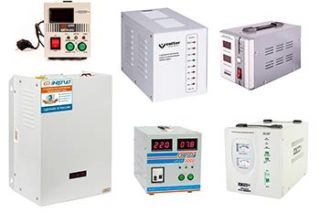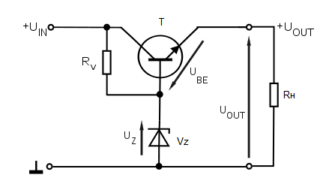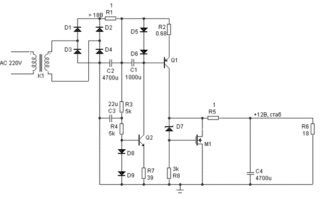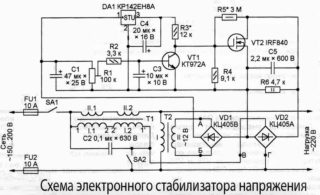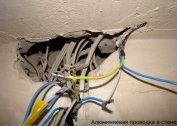Voltage stabilizers prevent damage to equipment and household appliances from load fluctuations. The device is compatible with single-phase and three-phase networks, suitable for apartments and private houses. A voltage stabilizer circuit may be needed when you connect the device yourself or install a power supply.
The principle of operation of stabilizers
The principle of operation depends on the type of equipment. To highlight the general points, it is advisable to consider the design. The device consists of the following elements:
- Control system. It allows you to track the output voltage, bringing it to a stable indicator of 220 V. The equipment operates with an error of 10-15%.
- Automatic transformer. Available in relay, triac, servo modifications. Increases or decreases the voltage rating.
- Inverter. The mechanism of the generator, transformer and transistors are equipped with inverter models. Elements through the primary winding can pass or turn off the current, forming a voltage at the output.
- Protective block, secondary power source. Available for 220 volt models.
The bypass or transit function allows the stabilizers to supply voltage to the output until the limit is suppressed.
The principle of operation of relay models
 The relay device regulates the voltage by closing the relay contacts. Parameters are controlled using a microcircuit, the elements of which compare the mains voltage with the reference voltage. If the indicators do not match, voltage regulator microcircuits receive signals to lower or increase the winding.
The relay device regulates the voltage by closing the relay contacts. Parameters are controlled using a microcircuit, the elements of which compare the mains voltage with the reference voltage. If the indicators do not match, voltage regulator microcircuits receive signals to lower or increase the winding.
With low cost and compactness, relay equipment slowly responds to power surges, can turn off briefly, and does not withstand overload.
The accuracy of the devices is 5-10%.
How Servo Drives Work
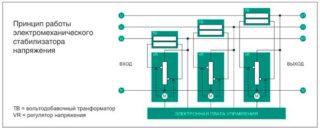 The main components of the servo-drive unit are a servomotor and an automatic transformer. If the voltage deviates from the norm, a signal is sent to switch the transformer from the controller to the motor. A comparison of the reference and input voltage indicators is carried out by the control board.
The main components of the servo-drive unit are a servomotor and an automatic transformer. If the voltage deviates from the norm, a signal is sent to switch the transformer from the controller to the motor. A comparison of the reference and input voltage indicators is carried out by the control board.
Servo stabilizers can regulate the load of a three-phase and a single-phase network. They are distinguished by durability, reliability, good functioning during overload.
The accuracy of the instruments is 1%.
The principle of operation of inverter devices
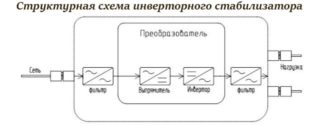 The inverter stabilizer regulates the voltage according to the double conversion system:
The inverter stabilizer regulates the voltage according to the double conversion system:
- The alternating current at the input is leveled, passed through a ripple capacitor filter.
- The rectified current is supplied to the inverter, transformed into alternating current and supplied to the load.
The output voltage remains stable.
Devices with inverters differ in speed of reaction, efficiency from 90%, uninterrupted and silent operation in the range of 115-300 volts.
The control range of the apparatus decreases if the load increases.
Features of the calculation of characteristics
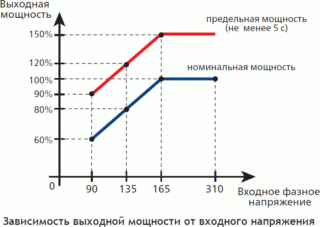 To install a parametric apparatus, you need to calculate the power, input voltage, base current of transistors. For example, the maximum output voltage is 14 V, the minimum output is 1.5 V, and the maximum current is 1 A. Knowing the parameters, the calculation is made:
To install a parametric apparatus, you need to calculate the power, input voltage, base current of transistors. For example, the maximum output voltage is 14 V, the minimum output is 1.5 V, and the maximum current is 1 A. Knowing the parameters, the calculation is made:
- Input voltage. Formula used Uin = Uout + 3. The figure is the voltage drop coefficient at the section of transition from the collector to the emitter.
- The maximum power dissipated by the transistor. To select in favor of a larger value, a reference is needed. The following formulas are used:Pmax = 1.3 (Uin-Uout) Imax = 1.3 (17-14) = 3.9 W; Pmax = 1.3 (Uin-Uout1) Imax = 1.3 (17-1.5) = 20.15 W.
- Current transistor base. Calculations are made according to the formula: Ib max = Imax / h21E min. The last indicator is 25, therefore 1/25 = 0.04 A.
- Parameters of ballast thyristor. The formula applies Rb = (Uin-Ust) / (Ib max + Ist min) = (17-14) / (0.00133 + 0.005) = 474 Ohms. Ist min - stabilization current; Ust - voltage stabilization, which produces a zener diode.
Figures and calculations are provided for resistors with a resistance of 1 ohm.
Scheme for compensation stabilizer
Compensation schemes explain feedback connections. The devices themselves have an accurate output voltage without reference to the load current.
Sequential circuit
By designation from the directory you can identify:
- regulatory unit - P;
- the source of the reference voltage rating - And;
- compared indicators - ES;
- constant current amplifier - W.
To calculate the output voltage, you need to know the features of the device. One transistor will regulate, and the second will stabilize. The zener diode is a reference source. Power difference - voltage in the area between the emitter and the base.
When the collector current is applied to the resistor, the voltage drops, it has the opposite polarity for the emitter assembly. As a result, the collector and emitter currents drop. To make the adjustment smooth, a divider is used for the stabilizer line. Step regulation is achieved by voltage stabilization of the zener diode.
Parallel circuit
If the voltage deviates from the nominal value, a mismatch pulse occurs. This is the difference between the exit and support indicators. Since the adjustment unit is parallel to the load, it amplifies the signal. There is a change in current on the element-regulator, the voltage drop of the resistor and the preservation of a constant value at the output.
Parametric stabilizer circuit
A diagram explaining the process of stabilizing the reference voltage will be basic for parametric models. The voltage divider of the device is a ballast resistor and a zener diode with parallel load resistance. If the nominal voltage and current load fluctuate, the voltage stabilizes.
If this indicator increases at the input, the current passing through the zener diode and resistor increases. Thanks to the current-voltage indicators, the zener diode rating is almost unchanged, as well as the load resistance voltage. All vibrations relate only to the resistor.
Pulse Specificity
The pulse apparatus is characterized by high efficiency even in a wide voltage range. The device diagram includes a key, an energy storage device and a control circuit. The control element is connected in pulse mode. The principle of operation of the device:
- A positive feedback voltage is supplied from the second collector through the second capacitor to the base.
- Collector No. 2 opens after current saturation from resistor No. 2.
- At the transition from the collector to the emitter, saturation is less and it remains open.
- The amplifier is connected to the collector number 3 through the zener diode number 2.
- The base is connected to the divider.
- The first zener diode controls the opening / closing of the second collector by a signal from the third.
When the second zener diode is open, energy accumulates in the inductor, entering the closing field to the load.
Chip Stabilizers
The linear divider is characterized by supplying an unstable voltage to the input and removing a stable divider from the arm. The alignment is carried out by a dividing arm, which maintains constant resistance. The devices are characterized by simplicity of design, the absence of interference in operation. Chips are connected in series or in parallel.
Series stabilizers
Serial devices are characterized by the inclusion of an adjustment element in parallel with the load. There are two modifications:
- With bipolar transistor. It does not have an auto-adjustable circuit; voltage stability depends on the current value and temperature indicators. An emitter follower or a composite type transistor is used as a current amplifier.
- With auto adjust loop. Compensation device works on the principle of alignment of the output and reference values. Part of the output voltage is removed from the resistive divider, and then compared using a zener diode. The control loop is a feedback loop with a phase shift of 180 degrees. The current is stabilized by a resistor or power source.
The most popular series stabilizers are integral.
Specifics of Parallel Stabilizer
A parallel device is characterized by the inclusion of an adjustment element parallel to the applied load. Zener diode is used semiconductor or gas discharge type. The circuit is in demand for regulating complex devices.
Reducing an unstable indicator of the input voltage is carried out using a resistor. It is allowed to use a bipolar machine with high differential resistance in a separate area.
Features of devices with three conclusions
Stabilizers for AC voltage are small in size, are available in a plastic or metal case. They are equipped with channels for input, grounding and output. The capacitors of the device are sealed on both sides to reduce ripple.
The output voltage is about 5 V, the input is about 10 V, the dissipation power is 15 watts.
Three-pin modifications allow you to get a non-standard voltage, necessary for powering breadboard models, low-power batteries, when fixing or upgrading equipment.
The self-assembly algorithm of the device
For self-production, it is advisable to use a triac circuit - an effective device. It equalizes the nominal current supplied at a voltage of 130 to 270 V. The device can be made on the basis of a printed circuit board made of foil-coated PCB. The assembly of the device is as follows:
- Preparation of the magnetic circuit and several cables.
- Creating a winding from a wire with a diameter of 0.064 mm - you need 8669 turns.
- The remaining conductors with a diameter of 0.185 mm are needed for the remaining windings. The number of turns of each is 522.
- 12 volt transformer series connection
- Organization of 7 branches. The first 3 are made of wire with a diameter of 3 mm, the others are made of tires with a cross section of 18 mm2. So the home-made device will not heat up.
- Installing the controller chip on a platinum heat sink.
- Installation of triacs and LEDs.
For the device you will need a durable case attached to a rigid frame. The easiest option is polymer or aluminum plates.
Stabilizer connection diagram
Entering the stabilizer in a private house is carried out using a three-core VVGng cable, a three-position switch and a PUGB wire. Installation is made to the meter, in a separate or distribution panel:
- Open the contacts by lifting the front cover.
- Pass the cable to the output and input.Tighten the input phase at the Lin terminal, the neutral (blue) conductor at the Nin terminal, and ground at the screw terminal with the corresponding designation.
- If there is no earth, screw this core under the screw on the device body.
- Return stabilized voltage to the common shield. The phase is fed to the output Lout, zero to Nout, ground to ground at the input.
- Test the circuit in no-load mode.
For the test, all machines are turned off, except for the input and directed to the stabilizer.
The stabilizer connected between the network and the load is suitable for a private or country house, apartment, production. The device protects the equipment from failure, eliminates the effect on the power line of overload and short circuits.
